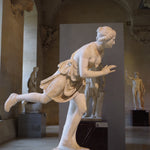Global Antiques and Fine Art
Thomas Creswick (1811-1869) British Oil Angler by River listed Museum artist- Christie's sales to 60,000 dollars
Regular price
$499.00 USD
Regular price
Sale price
$499.00 USD
Unit price
per
Couldn't load pickup availability
A lovely oil by famous British painter Thomas Creswick (1811-1869) depicting fisherman by river mountain landscape. On wood panel-signed lower left_ Very collectible work by well listed Museum painter who's auction prices have reached $58,982 (Christie's , 11 Jun 2004 United Kingdom). Thomas Creswick has a lengthy history of receiving very high auction records at both Sotheby's and Christies.
Title: Angler by River
Signature: Signed lower left
Medium: Oil on Painting
Size: c. 9 X 7 inches unframed, c 13 X 11 inches framed
Condition: Very good for age- No Paint loss or damage
Museum Holdings:
Victoria and Albert
Tate Gallery
Birmingham Museum (just some..many more have his work)
Free domestic shipping!
Returns & exchanges:
Returns accepted within 30 days of the purchase of the item. However, the buyer is responsible for shipping the item back to us and that cost will not be refunded. We will refund your money for the item as soon as we receive the item back. Please send the item back to us with tracking.
About the artist:
Creswick was born in Sheffield (at the time it was within Derbyshire). He was the son of Thomas Creswick and Mary Epworth and educated at Hazelwood, near Birmingham.
At Birmingham he first began to paint. His earliest appearance as an exhibitor was in 1827, at the Society of British Artists in London; in the ensuing year he sent to the Royal Academy the two pictures named Llyn Gwynant, Morning, and Carnarvon Castle. About the same time he settled in London; and in 1836 he took a house in Bayswater. He soon attracted some attention as a landscape painter, and had a career of uniform and encouraging, though not signal success. In 1842 he was elected an associate, and in 1850 a full member of the Royal Academy, which, for several years before his death, numbered hardly any other full members representing this branch of art.[2]
Worcester engraving by William Miller after Creswick
In his early practice he set an example, then too much needed, of diligent study of nature out of doors, painting on the spot all the substantial part of several of his pictures. English and Welsh streams may be said to have formed his favourite subjects, and generally British rural scenery, mostly under its cheerful, calm and pleasurable aspects, in open daylight. This he rendered with elegant and equable skill, color rather grey in tint, especially in his later years, and more than average technical accomplishment; his works have little to excite, but would, in most conditions of public taste, retain their power to attract.
Creswick was industrious and extremely prolific; he produced, besides a steady outpouring of paintings, numerous illustrations for books. He was personally genial, a dark, bulky man, somewhat heavy and graceless in aspect in his later years. He died at his house in Bayswater, Linden Grove, after a few years of declining health. Among his principal works may be named England (1847); Home by the Sands, and a Squally Day (1848); Passing Showers (1849); The Wind on Shore, a First Glimpse of the Sea, and Old Trees (1850); A Mountain Lake, Moonrise (1852); Changeable Weather (1865); also the London Road, a Hundred Years ago; The Weald of Kent; the Valley Mill (a Cornish subject); a Shady Glen; the Windings of a River; the Shade of the Beech Trees; the Course of the Greta; the Wharfe; Glendalough, and other Irish subjects, 1836 to 1840; the Forest Farm Frith for figures, and Ansdell for animals, occasionally worked in collaboration with Creswick.
Creswick has paintings in several British Collections including Sheffield, Canterbury, Derby Art Gallery and the Nothampton Gallery.




















